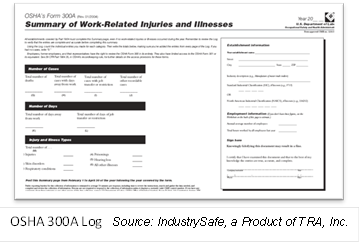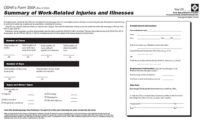This article will provide readers with an overview of the new final rule “Improve Tracking of Workplace Injuries and Illnesses” issued by the Occupational Safety and Health Administration (OSHA) to revise its recording and reporting requirements. Issued in May of 2016, this ruling requires employers in certain industries to electronically submit to OSHA injury and illness recordkeeping data.
This article will also explore the ways in which safety management software can assist with OSHA recordkeeping, and how OSHA intends to allow users of current recordkeeping software systems to submit their recordkeeping data electronically.
What are recordkeeping logs?
 Organizations that are required to complete OSHA recordkeeping are responsible for completing three types of recordkeeping log: the 301, 300, and 300A logs.
Organizations that are required to complete OSHA recordkeeping are responsible for completing three types of recordkeeping log: the 301, 300, and 300A logs.
The OSHA 301 log is an incident summary describing the who, what, when and where of each OSHA recordable incident. OSHA requires an OSHA 301 log to be completed seven days after the incident is reported.
The OSHA 300 log contains a line item for each OSHA recordable incident. Each location must have its own 300 log and the log must include a count of the number of missed and restricted days for each incident.
Unlike the 300 and 301 logs, which are maintained on a regular basis, the OSHA 300A log is completed after the end of the year, and provides a summary of all OSHA recordable incidents at each location. This log also includes the total number of hours worked and the total number of missed and restricted days.
What data on these recordkeeping forms does your organization have to submit electronically to OSHA?
Establishments with 250 or more employees will have to submit data contained in OSHA forms 300A, 300, and 301 with exceptions for fields with personally identifiable information (PII).
Establishments with 20-249 employees in high risk industries will have to submit all data fields currently contained in the OSHA form 300A.
When does your organization have to electronically submit this data to OSHA?
The final rule takes effect Jan. 1, 2017, and reporting requirements will be phased in over two years.Starting in 2019, organizations will have to submit the required data to OSHA electronically on an annual basis due by March 2 for data collected in the previous calendar year.
The following table contains key information about submission deadlines.
|
Submission Year |
Data Collected in Calendar Year |
Establishments with 250 or more employees |
Establishments with 20-249 employees |
Submission Deadline |
|
2017 |
2016 |
Form 300A |
Form 300A |
July 1, 2017 |
|
2018 |
2017 |
Forms 300A, 300, 301 |
Form 300A |
July 1, 2018 |
|
2019 |
2018 |
Forms 300A, 300, 301 |
Form 300A |
March 2, 2019 |
How can your organization electronically submit this data to OSHA?
According to the rule, OSHA will provide a secure web site for the electronic submission of OSHA recordkeeping information. The rule also provides that corporate or enterprise offices for organizations with control over multiple establishments will be able to submit electronically for all the establishments under their control.
OSHA intends to provide a web form for organizations to submit this data electronically.
How will OSHA protect the privacy of information?
Organizations will excludeemployee names from their electronic data submittals of the OSHA 300 and OSHA 301 logs.
In addition, organizations should also exclude the following data elements from their electronic submittals of the OSHA 301 log: employee address, name of physician or other healthcare professional, treatment facility name, and treatment facility address.
As a precaution, OSHA intends to scrub electronically submitted recordkeeping data for PII using software that will search for, and de-identify, personally identifiable information before the data are posted.
What will OSHA do with the submitted recordkeeping data?
OSHA plans to make the data readily available to the public in standard open formats on osha.gov. Interested parties will be able to search and download the data. OSHA’s goals for posting this data include encouraging employers to increase their efforts to prevent worker injuries and illnesses, and enabling researchers (and other groups) to examine these data in innovative ways that may help employers make their workplaces safer and healthier. The data will also enable OSHA to use its enforcement and compliance assistance resources more efficiently.
How can safety management software help with OSHA Recordkeeping?
Safety management software is an excellent tool that organizations can leverage to record, track and analyze incident data. Organizations can use safety software to record many types of incidents—including near misses, vehicle incidents, employee and non-employee injuries.
Safety management software can alert users if an incident needs to be reported directly to OSHA, or if it should be added to the appropriate recordkeeping logs. If an incident is determined to be OSHA recordable, users can automatically generate the applicable OSHA 301, 300, and 300A logs, allowing organizations to improve regulatory compliance and save valuable time and effort.
How will users of safety management software electronically submit recordkeeping data to OSHA?
To enable users of current OSHA recordkeeping software systems to submit their incident data electronically, OSHA intends to offer a file upload and an Application Programming Interface (API) and/or an Electronic Data Interface (EDI). OSHA intends to roll out this API and file upload tool at the same time as the secure web site and web form are launched for electronic data submission.
OSHA plans to provide specifications for the API and file upload tool in advance of the submission deadline.
Is there anything else you need to know about this new ruling?
In addition to requiring the electronic submission of recordkeeping data, the final rule includes provisions that prohibit employers from retaliating against workers for reporting a fatality, injury, or illness.
Section 11(c) of the Occupational Safety and Health Act already prohibits retaliation against employees who report a workplace incident. However, OSHA may not act under that section unless an employee files a complaint with OSHA within 30 days of the retaliation.
Under the new final rule, OSHA will be able to cite an employer for retaliation even if the employee did not file a complaint, or if the employer has a program that deters or discourages reporting through the threat of retaliation.
This new provision is important because it gives OSHA the ability to protect workers who have been subject to retaliation, even when they cannot speak up for themselves.
More information about OSHA Recordkeeping and the OSHA final rule are available from the following sources:
Read the Final Rule - https://federalregister.gov/a/2016-10443
Download OSHA’s Fact Sheet - https://www.osha.gov/Publications/OSHA3862.pdf
Frequently Asked Questions about the Rule - https://www.osha.gov/recordkeeping/finalrule/finalrule_faq.html
Learn more about the OSHA Recordkeeping Forms - https://www.osha.gov/recordkeeping/RKforms.html



